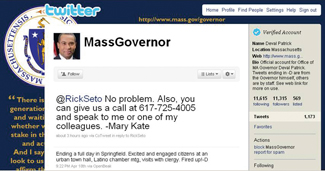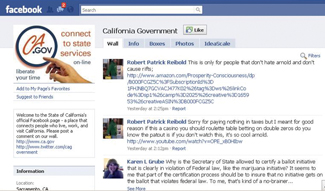Exploring Value in Social Media
 In President Barack Obama’s first day in office he issued a memorandum to federal agencies calling for the development of an Open Government Directive that focused on increasing transparency, collaboration, and participation. The directive requires agencies to take actions to expand access to government information, improve the quality of government information, create a culture of open government, and evolve policy in this direction. The directive points to “the use of new technologies,” many of which are based on social media platforms, “to promote greater openness in government.” Most recently, the administration issued a memorandum further encouraging the use of social media by clarifying that the Paper Reduction Act of 1995 “does not apply to many uses of such media and technologies.”
In President Barack Obama’s first day in office he issued a memorandum to federal agencies calling for the development of an Open Government Directive that focused on increasing transparency, collaboration, and participation. The directive requires agencies to take actions to expand access to government information, improve the quality of government information, create a culture of open government, and evolve policy in this direction. The directive points to “the use of new technologies,” many of which are based on social media platforms, “to promote greater openness in government.” Most recently, the administration issued a memorandum further encouraging the use of social media by clarifying that the Paper Reduction Act of 1995 “does not apply to many uses of such media and technologies.”
However, even with endorsement from the highest level, there is no official national blueprint for government to follow in adopting social media-based open government strategies. The extent and sophistication of use varies across levels of government. According to a 2009 survey by the Human Capital Institute and Saba, Inc., 66 percent of federal, state, and local government workplaces are using social networking tools. Governments are gravitating toward publicly available Web-based solutions such as microblogs (e.g., TwitterTM ), social network sites (e.g., Facebook©), videocasting (e.g., YouTube©) and photo-streaming (e.g., Flickr®). At the moment, the most popular are Facebook, Twitter, and LinkedIn.
It is clear that social media tools offer many potential benefits, but government agencies are struggling to understand the best way to incorporate and take advantage of the new capabilities these tools offer in the everyday work of government and to identify the public value derived from such investments.
Experimenting with Use in the Context of Government
Many governments see social media, first and foremost, as a new channel for delivering information and services. Social media channels offer more control over the type and timing of government-issued messages, provide a new platform to reach different audiences, and direct citizens to agencies’ Web sites in new ways.
Social media tools are shifting perceptions about how to best convey information. As a result, many agencies are re-packaging their existing content or creating content in new ways. The New York State Office for Children and Family Services (OCFS) explains its comprehensive community care program for foster children through a series of videos on its YouTube channel, Bridges to Health . The State of California turned its driver’s manual into a video, downloadable from iTunes® and accessible by mobile technology. The goal is to reach young drivers and offer a different way of learning to drive. The US Center for Disease Control (CDC) holds health fairs in Second Life©, a Web-based virtual world. Participants in this virtual space can go to the CDC virtual facility and ask questions, discuss relevant topics, and learn about important health issues. The space also features streaming video and numerous links to information on the CDC’s main Web site.
Interacting with citizens is another area where governments are exploring the potential of social media. Interaction can mean different things ranging from simply allowing “comments” on a Web site, to organizing contests that engage citizens in problem solving to spur innovation, to more sophisticated crowdsourcing approaches where citizens might help analyze large amounts of data.
“Our Web sites are like the stores on Main Street. Nobody visits our Web sites. We need to go to the mall. So Facebook is appealing, it’s like the mall.”
─Eddie Borges, Public Information Officer, NYS Office of Children and Family Services
The US Transportation Security Administration (TSA) uses “The TSA Blog” to communicate innovations in security, technology, and the checkpoint screening process. By allowing comments, the TSA can respond to misconceptions, customer service issues, and provide information on changes in regulations. The State of California Office of the Chief Information Officer is piloting IdeaScale to ask citizens and information technology (IT) professionals how to best use IT. Tools like IdeaScale allow government to solicit ideas from citizens who also rank them in order of importance through a voting system. The ideas that rise to the top can then be refined by California, fit in to the state context, and implemented. Despite its growing use, some government agencies remain uneasy about allowing comments on these different platforms, either because they do not have the processes or staff in place to be able to respond to the anticipated volume of comments, or have not settled on strategies to handle comments that are deemed inappropriate.
What do Citizens Want?
In the new social media landscape, governments are struggling to know “what do citizens want?” and “what do citizens expect?” Figuring out how citizens want government to communicate with them is not straight-forward. Governments walk a fine line between being where citizens are (i.e., Facebook) and avoiding the appearance of infringing on their private lives. Likewise, the style of communication associated with social media is informal and instantaneous, which sometimes presents a challenge for governments used to formalized communication involving layers of approvals and paper documents.
 Governments are learning how to respond to these challenges and adjust their practices accordingly. For example, when the State of Massachusetts Governor’s Office experimented with Twitter, their initial postings were mainly “links” to press releases. The feedback they received via Twitter indicated that citizens using this platform were not interested in formal interaction, which prompted the state to quickly adjust to a more informal style of “Twittering.”
Governments are learning how to respond to these challenges and adjust their practices accordingly. For example, when the State of Massachusetts Governor’s Office experimented with Twitter, their initial postings were mainly “links” to press releases. The feedback they received via Twitter indicated that citizens using this platform were not interested in formal interaction, which prompted the state to quickly adjust to a more informal style of “Twittering.”
“When we started using Twitter we thought this was going to be a great way to push out information. But very quickly, within a day or two, we started getting comments like, ‘don’t do it this way,’ ‘this is boring,’ ‘just talk to us.’ So, we did. We didn’t know what was going to happen.”
─Brad Blake, Director of New Media, State of Massachusetts, Office of the Governor
Managing citizen expectations is also complicated. Government must balance the expectations of “on demand” government with potential public backlash. To manage users’ expectations, the US Environmental Protection Agency posts a standard disclaimer that informs citizens that the comments posted after regular business hours will be responded to during the next business day. The disclaimer solved several concerns: it made it clear that employees were not expected and would not be paid overtime to log-on during non-work hours to answer comments and it tempered citizen expectations of receiving an immediate response.
Designing Policy
As governments across the US embrace social media, the need for social media policies has become apparent. Yet the details of what a social media policy should encompass and convey is not clear, and examples of such policies are far and few between. According to Gary Quinn, the CIO from Suffolk County in New York, “The issues connected with the use of social media tools are not necessarily new, but they do have to be reinterpreted for the social media context.”
The concerns that need to be addressed within a policy framework range from ensuring technical security to encouraging proper conduct of citizens and employees. A CTG review of social media policies across local, state, and federal agencies in the US revealed eight important social media-related concerns: employee access, account management, acceptable use, employee conduct, content, security, legal issues, and citizen conduct. Not all policies cover all eight concerns and not all concerns are covered to the same level of detail.
Eight Essential Elements for Government Social Media Policy
 Developing a social media policy can be an important first step for government agencies considering using social media and can ultimately serve as a key enabler for responsibly and effectively leveraging social media tools. Yet, many governments are struggling with what such a policy should encompass and convey and are looking to their peers for examples and best practices.
Developing a social media policy can be an important first step for government agencies considering using social media and can ultimately serve as a key enabler for responsibly and effectively leveraging social media tools. Yet, many governments are struggling with what such a policy should encompass and convey and are looking to their peers for examples and best practices.
CTG developed the first guide for government on designing social media policy. The guide identifies eight essential elements for a social media policy that address many of the concerns surrounding government’s use of social media. Along with detailed descriptions and numerous examples of the eight essential elements, the guide also includes an overview of the three types of social media use that fall within the domain of government social media policy and brief guidance on strategies for getting started.
The eight essential elements identified by CTG include: 1) employee access, 2) account management, 3) acceptable use, 4) employee conduct, 5) content, 6) security, 7) legal issues, and 8) citizen conduct.
Getting Started: Just Do It or Pilots
Some governments across the US are “jumping in,” while others are taking more measured approaches to social media, such as pilot testing. Usually, a jumping in effort starts because a leader or practitioner is enthusiastic about social media fulfilling a particular business need or function. These initiatives are generally small and limited in scope, allowing the originators an opportunity to evaluate potentialissues and adjust their practices as necessary.
Other initiatives begin as more formal pilot projects. Pilot projects are usually more structured, with the objective of creating formal social media strategies, best practices, and policies that can then be widely implemented. The New York State Education Department initiated a pilot consisting of eight department-level social media projects with a goal of learning enough to inform future agency-wide decisions on adoption.
“It was very clear we were already putting ourselves in much greater risk by having program offices use these tools without a policy or framework in place. So, we wrapped our arms around what was already happening, added several new ones, and created a pilot project to help us develop agency-wide governance, policies, and procedures.”
─Kathleen Moorhead, Project Manager, State of New York Education Department
Governments are also getting creative with resources. Several agencies are employing existing studio cameras, many of which were not being used to capacity, to make videos or are using off-the-shelf commercial software to edit pictures and movies. Many noted that this type of use requires a set of skills not always readily available.
Innovation in Collaboration
Social media is also being used to strengthen government collaboration and information sharing. Two examples are:
MuniGov2.0 is an online community of practice for government officials at all levels, focused on exploring the use of social media and Web 2.0. The site is a clearinghouse for definitions, best practices, examples, and discussions from around the US.
GovLoop was started in 2008 by Steve Ressler, at the time a federal employee, who created a social networking site specifically for government professionals, contractors, and students to connect and share information. Today the site has over 25,000 members.
Legal, Security, and Performance Issues
Publicly available social media platforms are popular, but they raise specific concerns for government agencies. Challenges yet to be resolved include Terms of Service agreements, performance and reliability, privacy, records retention, and security threats. Governments are tackling these issues as they emerge and looking to each other for guidance and best practices. In April 2009, the US General Services Administration (GSA) successfully re-negotiated the Terms of Service agreements for federal agencies for sites such as Facebook, Flickr, and YouTube to account for liability limitations, privacy, and freedom of information laws. Similar efforts on behalf of the states are being spearheaded by the National Association of State Chief Information Officers (NASCIO).
Liability. Liability limitations hinder government’s ability to hold third-party vendors accountable. As a result, government professionals are raising questions about the consequences of relying too heavily or solely on third party providers for dissemination of vital government information such as emergency alerts.
Privacy. The potential impact on privacy remains an important, yet somewhat downplayed, consideration. The Privacy Act of 1974 assures American citizens the ability to gain access to and amend records the federal government maintains about them and constrains government’s use of citizens’ personally identifiable information. According to analyses by the Electronic Privacy Information Center (EPIC), not all of the contracts negotiated by GSA explicitly reference the vendor’s obligation to comply with existing privacy and freedom of information laws. The inconsistent treatment of privacy laws requires further understanding, given the obligation of the federal government to ensure that all data collection practices comply with these laws.
Records Retention. Concerns about records retention are moving away from “do we classify social media content as a record?” to “what is the best strategy for making sure we retain the records we are legally obliged to retain?” But the definition of what constitutes a record varies from state to state. In New York, a record is defined as “any information kept, held, filed, produced or reproduced by, with or for an agency or the state legislature, in any physical form whatsoever.” Governments are erring on the side of caution and many consider all communication on social media sites to be a record.
Archiving such records and devising a process for retaining only those records an agency is legally obliged to retain is complex and archiving social media content is a relatively new issue. Some governments address retention issues by referencing existing records retention schedules or e-discovery guidelines in their social media policies. Under this approach, existing schedules apply to social media content, just as they apply to emails or feedback received via a comment box on an agency Web site. Some agencies are archiving content by simply cutting and pasting from very low volume social media sites; others are turning to new tools and services. For example, the US National Aeronautics and Space Administration (NASA) is using Archive-IT to archive all its social media interactions, including Facebook, Twitter, YouTube, and Flickr. In August 2009, the Executive Office of the President issued a Request for Proposals (RFP) for an automated process to capture, extract, and store information posted by White House employees on publicly accessible Web sites, including Facebook and Twitter.
Security. The Federal CIO Council recently issued a security white paper outlining three main security risks associated with social media use—spear phishing, social engineering attacks, and Web application attacks—and provided mitigation strategies. State governments are also creating their own security policies and mitigation strategies. There is broad agreement that security threats with respect to social media, similar to email, are largely behavioral in nature. Governments are examining mitigation strategies that closely mirror strategies for safeguarding email use, such as user training, anti-virus software, robust patch management systems, and standard network security infrastructure solutions including firewalls and intrusion detection.
“There is an inherent level of trust built into social media tools. Because these tools were built for collaboration and cooperation on a personal level and not with security in mind, their users are more susceptible to attack.”
─Information Security Officer, State Agency
Moving from Experimentation to Value Creation
 Governments are engaged in ongoing efforts to define success and to assess value from social media initiatives. The difficulty in doing so arises from two factors: first, the tools are relatively new and many agencies are still in an experimenting phase, and second, social media initiatives are only one component of a broader communication strategy for the agency.
Governments are engaged in ongoing efforts to define success and to assess value from social media initiatives. The difficulty in doing so arises from two factors: first, the tools are relatively new and many agencies are still in an experimenting phase, and second, social media initiatives are only one component of a broader communication strategy for the agency.
“Have we changed government by virtue of having that communication? It’s great to get all this feedback, but have we [government] changed the way we behave because of that? I don’t have a good answer for that yet.”
─Teri Takai, Chief Information Officer, State of California
“Within the last year, we’ve moved from just experimenting and piloting to really asking the tough questions. How much business value is it creating? And why are we spending public money on it?”
─P.K. Agarwal, Officer of Technology Services, State of California
Frameworks for judging the success of social media use in government are still being developed. Many governments are relying on monitoring popular Web metrics such as“number of views,” site specific analytics such as “number of fans,” free diagnostic tools (e.g., Google Analytics), or sporadic citizen-feedback received through various channels to make these judgments. However, using these measures or creating new ones requires a greater understanding about how social media can and does work in government and how common concepts such as “transparency,” “collaboration,” and “citizen services” must be reinterpreted.
It is clear that governments will continue to experiment with social media tools at a rapid pace in hopes of reaping the many potential benefits. The challenge for government officials and citizens alike is systematically answering the question, “Does social media use in government create new value for citizens?”
Natalie Helbig, Program Associate, Center for Technology in Government
Jana Hrdinová, Program Associate, Center for Technology in Government